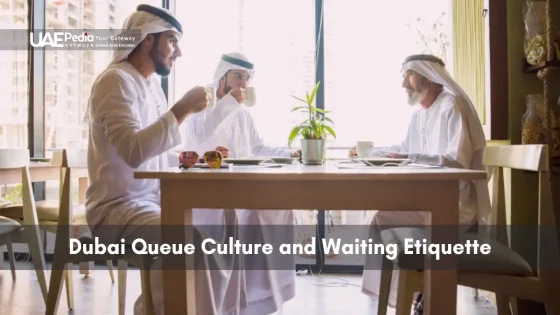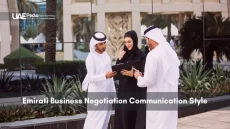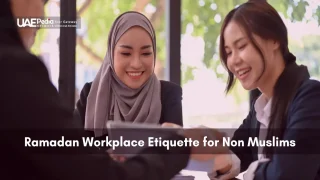Did you know the way people gather in public areas often reveals more about a place than its landmarks? In one of the world’s most dynamic hubs, the rhythm of daily life blends time-honored respect with contemporary pace—a balance that turns ordinary moments into cultural insights.
Here, courteous gestures carry the warmth of Emirati hospitality, while sleek systems reflect forward-thinking design. This fusion creates an environment where a smile or a polite nod holds as much weight as efficient crowd management. It’s not just about order; it’s about creating shared experiences in bustling settings.
Understanding these patterns transforms how visitors and residents interact. Whether at a metro station during rush hour or a weekend market, subtle cues—like maintaining personal space or allowing others to go first—show awareness of local values. These practices stem from deep-rooted traditions that prioritize community harmony.
Dubai’s public spaces combine Emirati etiquette with systematic crowd control. Visitors should use right-hand exchanges, maintain an arm’s-length distance or a half-step back in dense areas, and follow nonverbal cues—such as nods or slight steps—to indicate courtesy. Greeting protocols range from As-salam alaikum in formal settings to brief smiles or nods in busy environments. Gender-aware practices include men yielding to women and elders, and handshakes occurring only when initiated by a woman.
Service environments employ clear markings, staffed guidance and digital ticketing to streamline flow at government counters and retail outlets. Observing prayer-time adjustments—brief closures or reduced announcements—helps anticipate interruptions. Adhering to dress codes that cover shoulders and knees, avoiding line-skipping, and asking politely when queue origins are unclear ensures efficient and respectful navigation of crowded areas.
Key takeaways:
- Public interactions here blend heritage-inspired courtesy with modern efficiency
- Small acts of respect significantly shape daily experiences
- Practical awareness helps everyone navigate crowded areas smoothly
Exploring the Essence of Dubai’s Queuing Traditions
Greetings here act as cultural gateways—think of them as the unspoken rhythm guiding daily interactions. Centuries-old customs meet today’s fast-paced world, creating a unique blend of respect and practicality. You’ll notice this harmony in everything from market exchanges to business meetings.
Roots in Respect, Branches in Modernity
Traditional greetings like “As-salam alaikum” set the tone for courteous exchanges. Historically, elders or those in higher social positions received acknowledgment first. This practice still shapes how people approach shared spaces today. Women often lead by example, using subtle gestures to maintain harmony without words.
| Aspect | Traditional Practice | Modern Adaptation |
|---|---|---|
| Greetings | Verbal salutations first | Nods or smiles in busy areas |
| Handshakes | Wait for extended hand | Brief, gender-aware contact |
| Non-Verbal Cues | Lowered gaze as respect | Reserved personal space |
Silent Language of Courtesy
Watch how locals navigate crowded spaces—there’s poetry in their patience. A slight step back, a paused gesture inviting others forward—these small acts reveal deep-rooted values. In business settings, you might see someone hesitate before initiating a handshake, allowing the other party to set the tone first.
This careful dance of interaction isn’t about formality. It’s how communities honor shared spaces while embracing progress. Whether you’re attending a souk or corporate event, recognizing these patterns helps blend in seamlessly.
Read More:
Key Elements of Dubai Queue Culture and Waiting Etiquette
Ever notice how some crowds move like well-rehearsed dancers? Here, body language becomes a cultural signature. From market stalls to transit hubs, every gesture carries intention—especially when hands take center stage.
Right-hand exchanges aren’t just polite—they’re rooted in regional customs. Offering items or gestures with this hand shows respect, while the left stays reserved for personal use. Watch locals pass documents or payments: it’s a quiet ballet of palms turned upward, fingers never fully extended.
| Action | Traditional Approach | Contemporary Context |
|---|---|---|
| Handing Objects | Right hand only | Two-handed gesture in formal settings |
| Personal Space | Arm’s length distance | Half-step back in crowded areas |
| Eye Contact | Brief, respectful nods | Smile + nod combo during quick interactions |
Gender roles play out subtly. Men often pause to let women and elders proceed first—not as hierarchy, but as communal courtesy. Women might initiate movements by adjusting their pace, signaling others to pass. These rhythms create flow without spoken rules.
Three quick tips for seamless blending:
- Mirror others’ physical cues—if someone steps back, reciprocate
- Keep gestures contained near your torso
- Let those familiar with the space set the rhythm
This unspoken coordination turns crowded areas into stages for mutual respect. When we move with awareness, we become part of the city’s living tapestry—no words needed.
Using the right hand for greetings and exchanges is deeply ingrained in Emirati culture, symbolizing respect and cleanliness. Visitors should consistently use their right hand when offering or receiving items to align with local customs. Ref.: “Understanding UAE Etiquette and Customs: A Complete Guide.” UAE Stories. [!]
Navigating Waiting Etiquette in Government Offices and Malls
Ever wonder how a city thrives when order meets energy? In formal spaces, there’s an art to balancing structure with flexibility—like a well-oiled machine that still leaves room for human warmth.
Guidelines for Government and Administrative Settings
Government offices here run like precision clocks. You’ll find clearly marked lines and staff guiding flow. Patience isn’t just appreciated—it’s expected. Bring documents in advance and avoid phone calls while at counters. Pro tip: Arrive early; mid-morning often sees peak crowds.
Dubai’s government departments employ advanced queue management systems to streamline service delivery, ensuring efficient and orderly processing of visitors. Ref.: “Queue Management System for Government Departments in Dubai.” RSI Concepts. [!]
Steps to Respectful Queueing in Shopping Malls
Malls blend leisure with practicality. While lines feel more relaxed, basic rules still apply. At popular stores, staff might distribute numbered tickets during sales. Keep conversations hushed near service desks—voices carry in these glass-and-marble spaces.
Three universal principles for public areas:
- Let those ahead finish transactions before stepping forward
- If unsure where a line starts, ask politely
- Never bypass others—even if you’re in a hurry
Local resident Amal shares: “We value harmony—it’s why you’ll rarely hear horns in traffic or see pushing in shops. Calmness keeps everything moving.” Whether renewing a license or grabbing coffee, matching this rhythm shows respect for shared spaces and community norms.
“Check Out: UAE Dining Etiquette for Traditional Meals“
Gender Dynamics in Queue Behavior
Have you ever noticed how a simple gesture can speak volumes about cultural values? In public spaces, interactions between genders follow an unspoken script—one that balances tradition with modern social awareness. These moments reveal how respect shapes everyday encounters.
Understanding Interactions Between Men and Women
Non-verbal communication often sets the tone. Men typically wait for women to initiate greetings first, especially in formal settings. A slight nod or placing a hand over the heart—known as the “peace upon” gesture—serves as a common alternative to physical contact.
| Interaction | Traditional Practice | Modern Approach |
|---|---|---|
| Initiating Greetings | Women first, verbal acknowledgment | Brief eye contact + smile |
| Physical Contact | Rare outside family | Handshake if initiated by woman |
| Expressions of Respect | Lowered gaze | Stepping back to create space |
In Dubai, it’s customary for men to allow women to initiate greetings, particularly in formal contexts. This practice respects personal boundaries and cultural norms regarding gender interactions. Ref.: “Dubai Do’s and Don’ts – What Tourists Must Know in 2025.” City Life Dubai. [!]
Appropriate Handshakes and Greetings
When greetings do occur, they’re often brief and purposeful. As local etiquette coach Fatima explains: “If someone extends their hand, use your right palm lightly—it’s seen as a bridge of trust.” In mixed groups, many locals avoid prolonged touch, opting instead for verbal acknowledgments like “Marhaba” (welcome).
Three practical tips for visitors:
- Let women set the pace for physical interactions
- Use open-palm gestures when offering items
- Save hugs or cheek kisses for close acquaintances
These nuanced exchanges showcase how affection and respect coexist. By mirroring local customs, you honor traditions while fostering mutual understanding—one thoughtful gesture at a time.
“For More Information: Dubai Lifestyle Etiquette and Dress Code“
Understanding Body Language and Personal Space
What if every glance and gesture told a story? In public spaces here, movements often speak louder than words—especially near places of worship. The rhythm of daily life syncs with calls to prayer, shaping how people interact in shared areas.
Decoding Non-Verbal Cues in Public Settings
Watch how locals position themselves near mosques. During prayer times, you’ll notice subtle shifts—people stepping sideways to create pathways or clasping their hands loosely in front. These gestures signal awareness of others’ needs without verbal exchange.
Religious influences appear in small details. When approaching a mosque, many lower their voices and keep gestures contained. A local guide shares: “Open palms facing upward show respect here—like silently saying ‘peace be with you.’” This practice extends to markets and transit hubs too.
| Gesture | Meaning | Context |
|---|---|---|
| Hands clasped at waist | Patience or attentiveness | Waiting areas, prayer times |
| Stepping back | Inviting others to pass | Narrow corridors, crowded entries |
| Brief eye contact + nod | Acknowledgment | Service counters, group settings |
Three quick tips for visitors:
- Observe how others adjust spacing during calls to prayer
- Use your right hand when offering or receiving items
- Avoid pointing—gesture with an open palm instead
These silent signals create harmony in busy environments. By mirroring them, you honor local traditions while moving through spaces with ease—no phrasebook needed.
Dining and Hospitality Etiquette in the UAE
Imagine a meal where every gesture carries centuries of tradition—this is Emirati hospitality. Breaking bread here isn’t just about sustenance; it’s a dance of generosity and respect. From aromatic home feasts to polished hotel banquets, sharing food becomes a bridge between cultures.
Proper Use of the Right Hand in Social Settings
Your dominant hand takes center stage during meals. The right palm handles everything from passing mezze plates to accepting sweetened karak tea. Why? Local customs view this hand as clean and honorable. Chef Khalid Al-Mansoori explains: “We serve guests with our right—it’s like offering the best part of ourselves.”
| Scenario | Traditional Practice | Visitor Tip |
|---|---|---|
| Eating | Right hand only for touching food | Use utensils if uncomfortable |
| Greeting | Handshakes initiated with right palm | Light pressure, brief contact |
| Serving Others | Offer dishes right-handed | Rotate platters clockwise |
Homes and hotels elevate hospitality into art. Declining second helpings? Politely say “shukran” while placing your hand over your heart. Alcohol flows only in licensed venues—hotel bars are fine, but public consumption risks fines.
Three flavorful rules for visitors:
- Accept dates or coffee graciously—they’re symbols of welcome
- Leave a small bite on your plate to signal satisfaction
- Never photograph meals before hosts invite you to eat
Pro tip: If offered Arabic coffee, hold the cup with your right hand and sip slowly. It’s not just a drink—it’s a gesture of trust passed through generations.
“Read Also: Dubai Dating Rules for Unmarried Couples“
Embracing Cultural Traditions in Daily Interactions
Ever wondered how shared spaces become bridges between past and present? Across the Emirates, daily life weaves ancient customs with contemporary rhythms. This fusion turns simple acts—like choosing attire or pausing for prayers—into meaningful connections.
Observing Prayer Times and Religious Respect
Five times daily, cities slow as calls echo from minarets. During these moments, you’ll notice subtle shifts. Stores might temporarily close, and voices soften near mosques. Local guide Rashid advises: “Visitors aren’t expected to pray, but showing awareness—like avoiding loud calls during these periods—speaks volumes.”
| Setting | Traditional Practice | Visitor Consideration |
|---|---|---|
| Shopping Areas | Brief closures during prayers | Plan errands around schedules |
| Public Transport | Reduced announcements | Use headphone audio guides |
| Workplaces | Flexible break times | Reschedule meetings if needed |
RESOURCE REQUIREMENT:
During prayer times, businesses and public services in Dubai may pause operations, requiring visitors to plan activities accordingly to respect religious practices. Ref.: “Understanding UAE Culture: Customs, Dress, and Etiquette.” World Walker. [!]
Traditional Gestures and Forms of Affection
Greetings here carry layered meanings. A hand placed over the heart often replaces handshakes between genders. Families might press noses lightly—a Bedouin-rooted sign of warmth. These gestures thrive in homes and social areas but stay reserved in formal places.
Three ways to honor cultural etiquette:
- Choose loose-fitting clothes covering shoulders/knees in heritage areas
- Wait for locals to initiate physical contact
- Compliment hospitality with “Allah yekhalik” (May God preserve you)
From bustling markets to quiet desert retreats, these traditions create invisible threads connecting communities. By mirroring them, you don’t just visit—you become part of the story.
“Dive Deeper: Dubai Mosque Visiting Rules for Tourists“
Essential Tips for Tourists and Business Visitors
What if blending into a new city’s rhythm was as simple as knowing a few key moves? For travelers and professionals alike, mastering public spaces here becomes effortless with mindful preparation. Let’s explore strategies that turn potential stress points into smooth interactions.
Smart Strategies for Shared Spaces
Start by syncing your schedule with local patterns. Mornings see lighter crowds at metro stations, while evenings buzz at popular attractions. Travel blogger Lena Torres notes: “Downloading a metro app saved me 15 minutes daily—time better spent exploring souks!” Digital tools like eSIMs keep you connected without hunting for Wi-Fi.
| Tool | Use Case | Benefit |
|---|---|---|
| eSIM Providers | Real-time transit updates | Avoid peak-hour delays |
| Queue Apps | Virtual lines at attractions | Maximize sightseeing time |
| Translation Apps | Decoding signage | Navigate stations confidently |
Dress codes matter more than you’d think. Opt for breathable fabrics that cover shoulders in formal settings—it shows respect and helps blend in. Business meetings often start precisely on time; arrive five minutes early to account for security checks.
Three golden rules for hassle-free days:
- Carry a reusable water bottle—hydration stations abound
- Let locals guide the pace in crowded areas
- Smile often—it’s the universal language of courtesy
With these insights, your visit becomes less about navigating and more about connecting. Every interaction becomes an opportunity to learn—and maybe even share a tip with future travelers!
“Further Reading: Arabic Greetings for Everyday Use in Dubai“
Final Thoughts on Respectful Queuing and Cultural Etiquette
Every removed pair of shoes at a mosque entrance or adjusted shoulder cover isn’t just politeness—it’s a brushstroke in Arabia’s living cultural canvas. These gestures, small but intentional, weave personal awareness into shared spaces. They turn routine moments into bridges between tradition and tomorrow.
Keep mind what we’ve explored: right-hand exchanges, contained gestures, and letting others set the rhythm. Whether adjusting your stance in crowded areas or choosing attire that respects local norms, you become part of a story older than skyscrapers. Even how you hold a coffee cup or pause during prayer times speaks volumes.
Engaging in culturally respectful behaviors, such as using the right hand for eating and acknowledging prayer times, enhances social harmony and visitor experiences in Dubai. Ref.: “Cultural Etiquette in Dubai: Essential Do’s and Don’ts.” Unlock Dubai. [!]
Three final reminders for smooth experiences:
- Mind your shoulders and shoes—they’re silent ambassadors of respect
- Let curiosity guide you, not assumptions
- Small courtesies spark big connections
Now picture yourself moving through vibrant markets or sleek transit hubs with quiet confidence. You’re not just visiting—you’re adding your thread to the tapestry. Pack these insights, keep mind open, and step into experiences where every gesture matters. The real magic lies not in avoiding missteps, but in embracing the dance.
Cutting in front of others, using phones loudly, or ignoring designated lines (like separate counters for women or seniors) can come off as disrespectful. Patience is key—avoid sighing or gestures of frustration, even if waits feel long. Pro tip: Arrive early to beat crowds!
Yes! Many malls, metro stations, and airports have priority lanes for women, families, or people of determination. Look for signage—these aren’t just courtesies but formal systems. Men should avoid these lanes unless accompanying children or those needing assistance.
In Emirati culture, the left hand is traditionally seen as unclean. Passing dishes, accepting coffee, or shaking hands with your right shows respect. If you’re left-handed, a quick “excuse me” with a smile smooths things over—it’s about intention, not perfection.
During calls to prayer, many Muslims pause for salat. Non-Muslims aren’t expected to pray, but lowering your voice, avoiding walking in front of those praying, and pausing transactions (if staff step away) shows cultural sensitivity. Malls often post prayer timings—check them to plan around brief pauses.
Light hugs between same genders are fine, but avoid prolonged embraces or PDA with romantic partners. High-fives? Keep them chill—boisterous behavior (like shouting or backslaps) might draw stares. When in doubt, mirror the energy of those around you.
Shoulders and knees covered is the golden rule, especially in government buildings or mosques. Beachwear belongs at the pool—throw on a light scarf or cardigan before entering malls or souks. Bonus: It helps with AC chills!
Emiratis often stand closer during chats than Westerners—don’t step back abruptly. But in queues, maintain a modest gap (about an arm’s length). Avoid touching strangers beyond a polite handshake, and never pat someone’s head—it’s considered invasive.
Licensed venues in hotels or certain zones allow it, but public intoxication is illegal. Sip discreetly—no rowdy toasts or carrying open containers outside. Ramadan adds stricter rules: no daytime drinking, even in private, unless venues have screened-off areas.

















